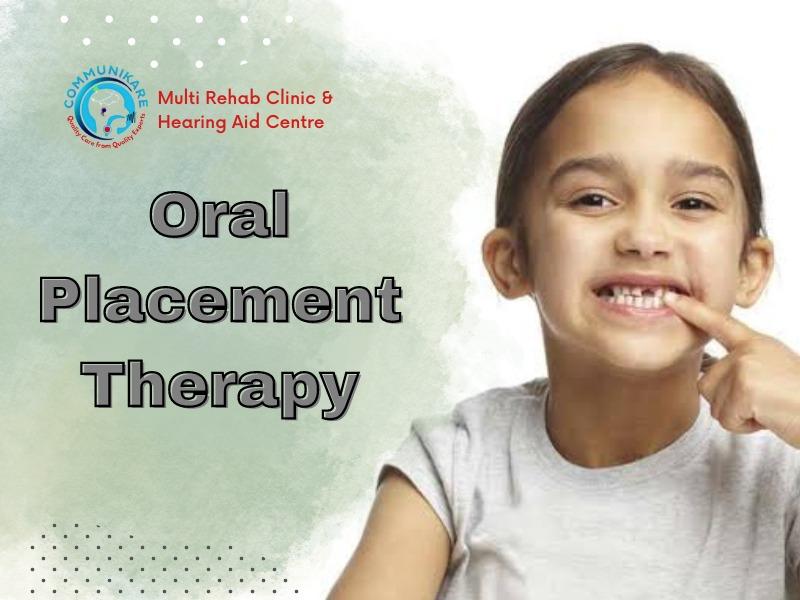Oral Placement Therapy
Admin
December 19, 2022

Communikare’s Oral Placement Therapy
Oral Placement Therapy is a speech therapy that improves speech clarity using a mix of
auditory stimulus, visual stimulation, and tactile stimulation to the mouth.
This is a crucial supplement to conventional speech therapy techniques for clients with
placement and movement difficulties. This strategy, in conjunction with conventional speech
therapy techniques, is highly helpful in assisting non-verbal children in transitioning to
speech and beyond. It is a tactile-proprioceptive teaching method that supplements
conventional therapy. The majority of traditional therapy is aural and visual. In addition,
this strategy is very useful when assisting children with feeding issues or food allergies.
Because communication is a tactile-proprioceptive act, clients with motor or sensory deficits
can benefit from tactile and proprioceptive components. OPT is utilised to enhance
articulator awareness, placement, stability, and muscle memory, all of which are essential for
the development of speech intelligibility.
OPT is applicable to clients of all ages and skill levels. It can be incorporated into
programme designs for a variety of communication impairments, such as Dysarthria,
Apraxia of Speech, Down Syndrome, developmental delays, Voice disorders, fluency
disorders, and clients with mild to extensive hearing loss.
OPT trains clients who cannot make or copy speech sounds using traditional auditory or
visual input oral structural placement. It is essential for these individuals to increase their
speech sound production beyond the phonemes and other related mouth movements they
can now make.
According to the founder of TalkTools, speech is the product of four essential parts of
muscular movement:
- Understanding of the oral structures
- The position of the oral structures
- Stability, resistance to fatigue, and muscle memory
- Production
Visit Communikare for additional information regarding the application of this specific
approach. In addition, you will learn what tools are employed in this therapy approach to
bring about effective improvements in the child.
Oral Placement Therapy is a form of speech therapy that combines:
- Auditory stimulation
- Visual Stimulation
- Tactile stimulation to enhance the clarity of speech.
Once a client is able to make the desired speech sound via standard auditory or visual input,
speech therapy can proceed in a more conventional fashion.
Play is to a child what language is to an adult. It is a medium for expressing emotions,
examining relationships, recounting experiences, revealing desires, and achieving one’s
goals. The difficulties children face cannot exist separate from who they are as individuals.
Play therapy combines the child’s dynamic inner structure with a similarly dynamic
technique.
In play therapy toys are considered as the child’s words and play as the child’s language–a
language of movement. In play therapy, the symbolic role of play is crucial because it allows
children to communicate their inner world.
Play therapy enables children to sort through complex emotions and speak on their own
terms through play, without feeling interrogated or intimidated. BAPT is the British
Association of Play Therapists. This is a crucial part of play therapy because traditional
therapy can be daunting for both children and adults, which does not necessarily foster an
environment favourable to self-expression.
Toys allow youngsters to project their anxieties, fears, dreams, and guilt onto inanimate
items rather than other people. In the safe environment of play therapy, children explore the
unexpected and build experiential-emotional and cognitive knowledge. Then, it may be
claimed that through play therapy, the unusual becomes familiar, and children express what
has occurred internally through play.
In addition to these benefits, children learn the notion of sharing, how to take turns, engage
with their peers, and listen to what others have to say when they play with a group of
children.
Through symbolic representation, play therapy transforms situations that may be
overwhelming in reality into situations that are manageable, so providing children with
opportunities to learn to cope.
Therefore, in play therapy, rather than simply sitting with children and asking them
questions, therapists let them play throughout sessions. Play therapy can be nondirective,
such as letting a child play with sand to reduce tension, or directional, such as having the
child use puppets to narrate a tale about his or her family in order to understand more about
the child’s family dynamics.
Communikare provides play therapy for children who lag behind in play activities, such as
pretend play, parallel play, and rule-based play, as well as for children who struggle to
handle a range of toys efficiently



Categories

We Care for Your communication,
Quality Care from Quality Experts.
Quick Links
Subscribe Our Newsletter
You’ll receive regular updates on our special offers, and other exciting news.
www.communikare.in